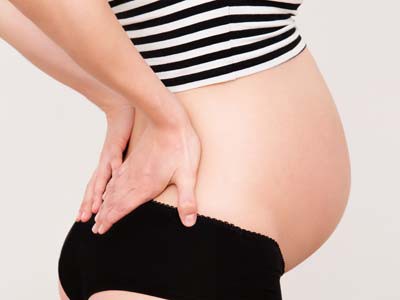A pain often trivialized during this period: "It's normal to have back pain for a pregnant woman, because her body is changing!". This type of speech drives me mad: It's not normal to be in pain!! Admittedly, it is common, but is that why expectant mothers should be left to suffer? According to studies, we find up to 50% of pregnant women suffering from this type of pain. In addition, for about 25% of them, this pain will continue during the postpartum period.
They can start at any time of pregnancy, even very early, from the 12th week. However, they often occur between 5 and 7 months of pregnancy, to reach a plateau until the end of it, and gradually decrease postpartum. Low back pain mostly resolves within the first six months postpartum. However, they can persist beyond that. In the following article, we will discuss the causes of low back pain during pregnancy, the risk factors, the consequences, and finally the treatment available to relieve and prevent your pain.
The main causes of low back pain during pregnancy:
Increasing the lumbar arch:
With the increase in weight and volume of the uterus, the center of gravity gradually shifts forward, which disturbs the lumbar mechanics, the arch that we have in the lower back will increase, we speak of hyperlordosis.
This will have two main consequences:
- The position of the vertebrae relative to each other will be modified. The weight constraints will be distributed differently on the joint surfaces which can create pain.
- The back muscles are going to have to work differently to counterbalance the weight. This muscle stress can be the cause of back pain
Hormones :
Hormonal impregnation also plays a role in low back pain during pregnancy. The hormones involved are relaxin and progesterone:
- -La relaxin will have (among other things) the role of relaxing the ligaments to allow the opening of the pelvis. The pelvis being the base of the lumbar spine, the biomechanical modification of the latter can create instability on the lumbar vertebrae and cause pain. Several studies have shown a correlation between increased relaxin levels and low back pain.
- -The increase in the rate of progesterone during pregnancy will decrease muscle excitability, which can affect the resistance of the back muscles and create pain.
Back muscles:
Between the hormonal impregnation, the increase in weight constraints and the decrease in activity, the "muscular resistance" is disturbed. This is why the pain will be accentuated after prolonged standing, inappropriate efforts or at the end of the day. The muscles "fatigue" and cause pain.
Psycho-behavioral causes:
The decrease in frequent physical activity during this period, fatigue, insomnia, nausea and psychological factors such as stress or depression are also to be taken into account in the occurrence of lower back pain.
Risk factors :
The probability for a woman to have low back pain decreases with age (among women under 20: 90% are affected by this pain).
Sedentary women are more at risk. The initial muscular potential is low, so adaptation to the transformations of pregnancy can be more complicated.
Women who had a history of low back pain before pregnancy, during menstruation, during a previous pregnancy are at risk of significant recurrence pregnant.
Consequences :
Lower back pain is the leading cause of work stoppages during this period, with the economic fallout that this generates.
Nighttime pain can disrupt sleep.
Postpartum depressive symptoms are three times more prevalent in women with lombopelvic pain than in those without.
Patients with lombopelvic pain are 3 to 6 times more likely to have depressive symptoms during pregnancy.
Prevention :
Adapted physical activity before conception and from the start of pregnancy, strengthening the muscles that will be better able to adapt to the changes of pregnancy.
Walking, swimming or the stationary bike can mobilize the lower back so distribute the stresses on all the articular surfaces, it also allows to keep a good hydration and vascularization of the peri-articular tissues. 2-3 times a week, do muscle strengthening with moderate to low stress.
It is important to maintain a healthy lifestyle, with a balanced and appropriate diet. You don't have to "eat for two".
Drinking enough water is essential to allow good blood circulation and good tissue hydration.
Treatments :
Pursue preventive actions.
The best treatment being movement, it is important not to lie all day long in front of Netflix. Prolonged static standing and sitting positions are also to be avoided.
Limit the wearing of inappropriate loads in case of pain.
Pregnancy belts can help provided they are used correctly. There are three types, those which will provide support to the stomach, those which will provide lumbar support and those which will have a role of stabilizing the pelvis. A health professional, the physiotherapist (physiotherapist), will be able to guide you on this choice. Please note, support belts should be worn in moderation!
Conclusion:
Numerous studies have therefore shown that appropriate physical activity and lifestyle advice can prevent and relieve lower back pain. I am saddened to see that treatment by masseur-physiotherapists, specialists in movement and low back pain, is not more popular! We can really be key players.
It can't be a financial issue. If care can reduce work stoppages and postpartum depression, social security regains its investment thanks to this prevention. It may be a lack of knowledge of the actors monitoring the pregnancy or a trivialization of these pains during this period. Do not hesitate to discuss it with your doctor!
On the other hand, acupuncture, sophrology or osteopathy can be interesting alternative solutions depending on the sensitivity of women.
Julie CANTOURNET, Massage therapist DE


